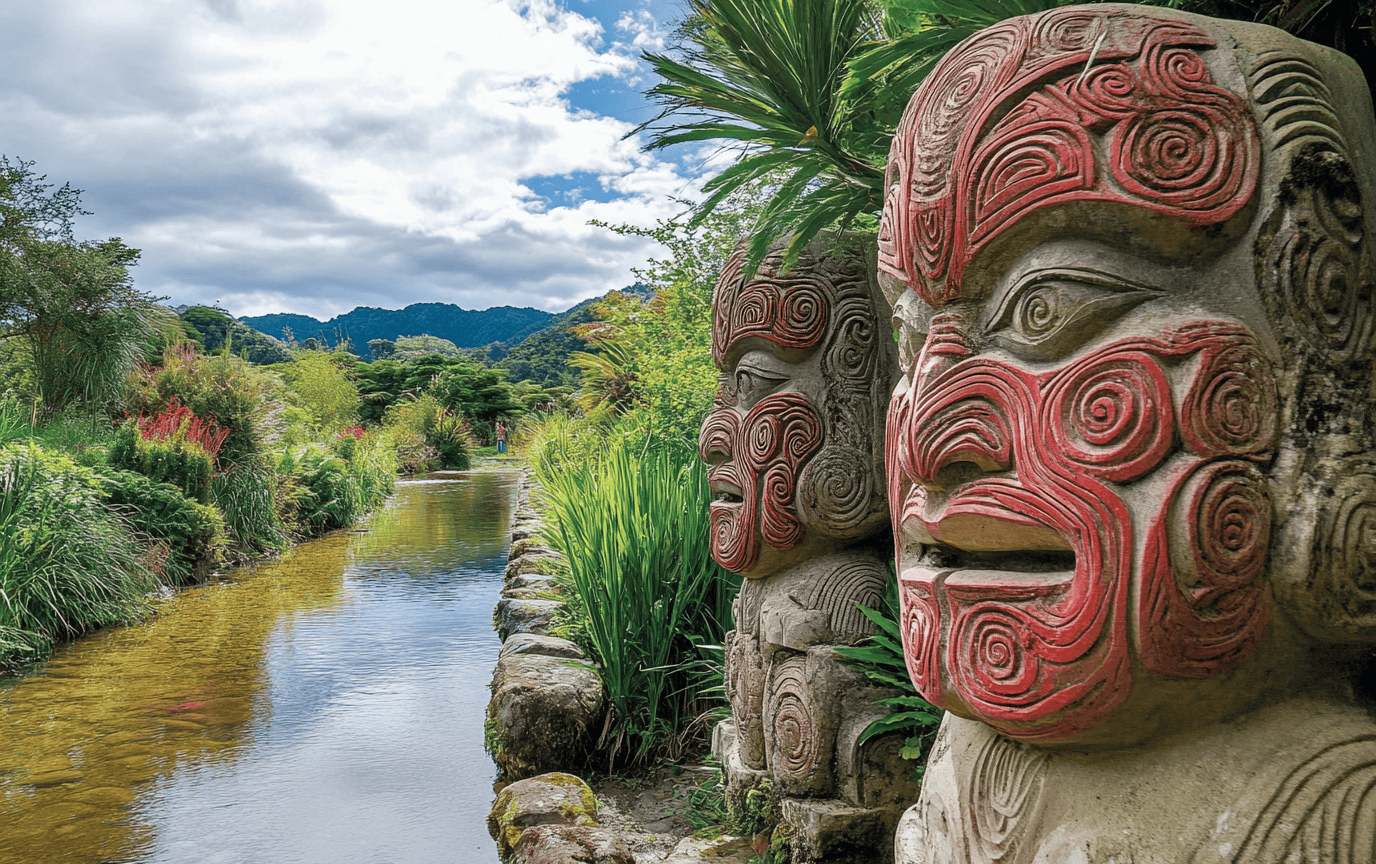Exploring Maori Culture in New Zealand: A Journey Through History, Traditions, and Modern Life
New Zealand, a land woven with breathtaking landscapes and a rich tapestry of cultural heritage, is not merely a geographical location, but a vibrant canvas painted by the indigenous Maori people. Their profound connection to the land, their stories etched in every hill and river, shape not just a culture, but the very identity of this country. From the resonance of the haka dance to the intricate patterns of ta moko, their indigenous traditions pulse with life, anchoring the past to the present and into the future.
Come, fellow travelers, let us take a journey through the heart of Maori culture. We will explore its history, traditions, and the modern-day practices that breathe life into this remarkable heritage.
History of the Maori
The arrival of the Maori in New Zealand traces back to approximately the 13th century, when they traversed the vast Pacific Ocean in large, meticulously crafted ocean-going canoes. Their legends speak of Hawaiki, a mythical land often associated with Tahiti, from where these ancestors fled to rewrite their destinies. Their stories and genealogies serve as blueprints, connecting them to the land and each other.
As the waves crashed upon the shores of their new world, they cultivated their existence, forming tribal structures that balanced community and the natural environment. But the horizon shifted in the 17th century. Abel Tasman, the first European to chart the waters around New Zealand, cast the first stone into this pristine pond of life. Yet it was Captain James Cook’s arrival in 1769 that would create ripples expanding into turbulent waters.
Interactions with Europeans brought forth a mixture of exchange and adversity. The Maori encountered muskets, diseases that swept through their populations, and Western agricultural practices that disrupted their traditional ways. Tensions rose as land was seized and borders redrawn, a collision of cultures unfurling before their eyes.
Maori Traditions and Practices
Maori culture is celebrated for a plethora of traditions and practices, each offering a glimpse into their worldview.
Ta Moko (Tattooing)
The intricate art of ta moko goes beyond aesthetics. Every swirl and line inked onto the skin tells a story of ancestry, social status, and personal achievement. When you gaze upon a Maori’s tattooed face, you’re not merely viewing art; you’re peering into a tapestry of their life journey, a silent language that speaks to history and tradition.
Hangi (Underground Cooking)
Ah, the hangi. Imagine earthy aromas wafting through the air, as the food steams slowly, enveloped in the warmth of heated stones buried deep in the ground. This traditional cooking method, passed down through generations, signifies not just nourishment but embodies a shared experience, cementing bonds during weddings, funerals, and feasts. It’s a communion with ancestors, a reminder that they are never alone.
Haka (Traditional Dance)
Then, there’s the haka. More than just a dance, it’s a visceral expression of unity, strength, and cultural pride. The powerful stomps echo the heartbeat of a people, while the fierce chants serve as a wake-up call to the spirit. Picture yourself witnessing a haka performed by a tribe, an electric moment that sends a shiver down your spine. You feel it in your bones—the respect, the honor and the unyielding spirit.
Te Reo Maori (Maori Language)
Once the dominant tongue in these lands, Te Reo has seen its ebb and flow. Efforts to revive and perpetuate the language are echoed in modern New Zealand, where it resonates in education, media, and the hearts of its people. To hear “Kia ora” spoken fluently is to feel an embrace through words, a welcoming gate to a vibrant culture.
Marae (Maori Meeting Grounds)
Every journey into Maori territory should begin at a marae. The sacred grounds serve as epicenters of cultural identity, where guests partake in a powhiri, a sacred welcome. You can almost feel the land breathe alongside you as the elders chant and sing, carrying centuries of tradition in their voices. It’s a reminder of the ceremonial dance of life that continues between humans and their landscape.
Experiencing Maori Culture in New Zealand
If you seek authentic experiences that immerse you in Maori culture, New Zealand provides a myriad of opportunities for deep engagement.
Waitangi Treaty Grounds
Many travelers begin their journeys at the Waitangi Treaty Grounds, the genesis of New Zealand’s bicultural identity. Here, the Treaty of Waitangi was signed in 1840, a foundational document for both the Maori and the Crown. This site is not merely a tourist destination; it’s a pilgrimage to understand the earthy roots of conflict and compromise. Walking the grounds, the weight of history settles upon your shoulders, a reminder that every conversation about identity must begin with understanding the past.
Rotorua
Then travel to Rotorua, where geothermal wonders meet a vibrant Maori cultural tapestry. This town is alive with the whispers of ancestors and bubbling mud pools. Dive into the world of Whakarewarewa, a living village that has hosted guests for over two centuries. Here, you can witness the old traditions and partake in shared stories over a sizzling hangi meal while gazing into the expansive horizon.
Maori Cultural Performances
Don’t miss the captivating Maori cultural performances found throughout the country. Go to Te Pa Tu (formerly Tamaki Maori Village) to participate in an evening that combines rich storytelling with a sensory feast—traditional dances that leap from the ground and the taste of a traditional hangi lingering on your palate. Each flick of the wrist, each stomp of the foot, speaks of a life lived in honor of ancestry.
South Island Adventures
Though the South Island is less populated by Maori, the connection to tradition remains. In hidden corners, greenstone-carving workshops thrive, allowing you to engage with artisans who sculpt jade into delicate shapes. The allure of pounamu transcends mere stone; it’s a cherished treasure, a spiritual link to the very essence of Maori identity.
Modern Maori Culture
Fast forward to today, and the spirit of the Maori thrives. Comprising some 17% of New Zealand’s population, Maori people play an active role in reshaping their identity within a contemporary context, navigating social challenges while breathing life into their culture.
Tradition dances hand in hand with modernity; sacred sites have been recognized, mountains granted personhood, a reverent acknowledgment of the spiritual world embedded within nature. The narrative of resilience and revival continues to unfold, with younger generations reclaiming their language and traditions in schools and communities.
Conclusion
The vibrant world of Maori culture is a profound exploration through history, traditions, and modern life. Each visit unveils layers of meaning—from the fierce energy of the haka to the delicate artistry of ta moko, each thread of tradition is woven into the fabric of New Zealand’s identity.
As you traverse this unique landscape, remember: every experience from the Waitangi Treaty Grounds to a traditional hangi is a chapter of a story that remains alive. It’s a reflection of the Maori people—strong, resilient, their culture not merely preserved but celebrated, growing ever richer with time.
Explore, listen, and immerse yourself in a shared journey that acknowledges both the past and the future. The Maori culture, like the land it arises from, is boundless.
Interested in more insightful reads? Check out our Travel Tips section for the latest advice. For lifestyle inspiration, explore our Lifestyle category, and dive into amazing destinations at Destinations. Don’t forget to connect with us on YouTube, or follow our adventures on Instagram and Pinterest.













